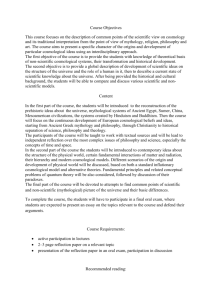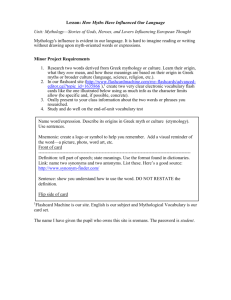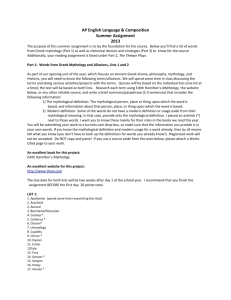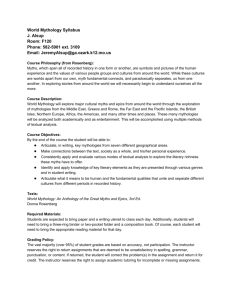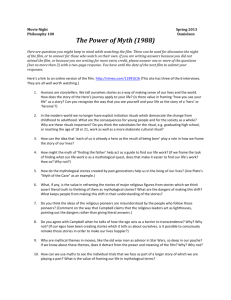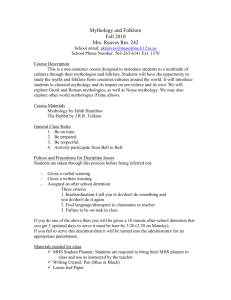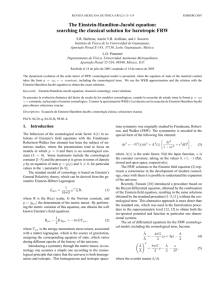Joseph Campbell - Woodside Priory School
advertisement
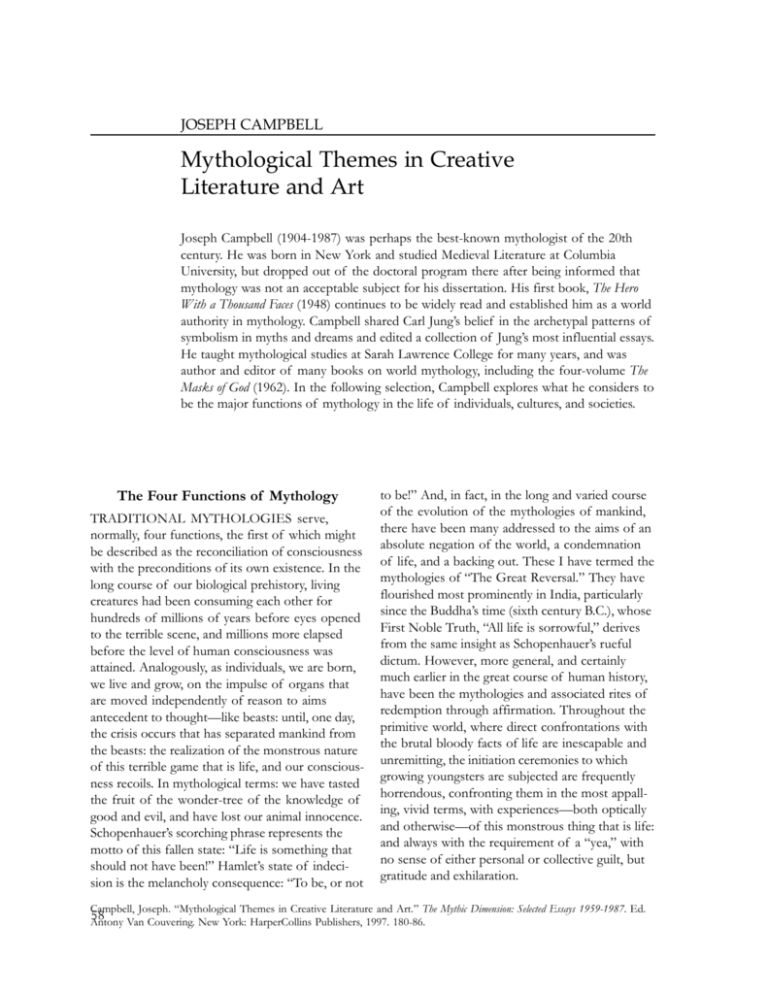
JOSEPH CAMPBELL Mythological Themes in Creative Literature and Art Joseph Campbell (1904-1987) was perhaps the best-known mythologist of the 20th century. He was born in New York and studied Medieval Literature at Columbia University, but dropped out of the doctoral program there after being informed that mythology was not an acceptable subject for his dissertation. His first book, The Hero With a Thousand Faces (1948) continues to be widely read and established him as a world authority in mythology. Campbell shared Carl Jung’s belief in the archetypal patterns of symbolism in myths and dreams and edited a collection of Jung’s most influential essays. He taught mythological studies at Sarah Lawrence College for many years, and was author and editor of many books on world mythology, including the four-volume The Masks of God (1962). In the following selection, Campbell explores what he considers to be the major functions of mythology in the life of individuals, cultures, and societies. The Four Functions of Mythology TRADITIONAL MYTHOLOGIES serve, normally, four functions, the first of which might be described as the reconciliation of consciousness with the preconditions of its own existence. In the long course of our biological prehistory, living creatures had been consuming each other for hundreds of millions of years before eyes opened to the terrible scene, and millions more elapsed before the level of human consciousness was attained. Analogously, as individuals, we are born, we live and grow, on the impulse of organs that are moved independently of reason to aims antecedent to thought—like beasts: until, one day, the crisis occurs that has separated mankind from the beasts: the realization of the monstrous nature of this terrible game that is life, and our consciousness recoils. In mythological terms: we have tasted the fruit of the wonder-tree of the knowledge of good and evil, and have lost our animal innocence. Schopenhauer’s scorching phrase represents the motto of this fallen state: “Life is something that should not have been!” Hamlet’s state of indecision is the melancholy consequence: “To be, or not to be!” And, in fact, in the long and varied course of the evolution of the mythologies of mankind, there have been many addressed to the aims of an absolute negation of the world, a condemnation of life, and a backing out. These I have termed the mythologies of “The Great Reversal.” They have flourished most prominently in India, particularly since the Buddha’s time (sixth century B.C.), whose First Noble Truth, “All life is sorrowful,” derives from the same insight as Schopenhauer’s rueful dictum. However, more general, and certainly much earlier in the great course of human history, have been the mythologies and associated rites of redemption through affirmation. Throughout the primitive world, where direct confrontations with the brutal bloody facts of life are inescapable and unremitting, the initiation ceremonies to which growing youngsters are subjected are frequently horrendous, confronting them in the most appalling, vivid terms, with experiences—both optically and otherwise—of this monstrous thing that is life: and always with the requirement of a “yea,” with no sense of either personal or collective guilt, but gratitude and exhilaration. Campbell, Joseph. “Mythological Themes in Creative Literature and Art.” The Mythic Dimension: Selected Essays 1959-1987. Ed. 58 Antony Van Couvering. New York: HarperCollins Publishers, 1997. 180-86. Joseph Campbell For there have been, finally, but three attitudes taken toward the awesome mystery in the great mythological traditions; namely, the first, of a “yea”; the second, of a “nay”; and the last, of a “nay,” but with a contingent “yea,” as in the great complex of messianic cults of the late Levant: Zoroastrianism, Judaism, Christianity, and Islam. In these last, the well-known basic myth has been, of an originally good creation corrupted by a fall, with, however, the subsequent establishment of a supernaturally endowed society, through the ultimate world dominion of which a restoration of the pristine state of the good creation is to be attained. So that, not in nature but in the social order, and not in all societies, but in this, the one and only, is there health and truth and light, integrity and the prospect of perfection. The “yea” here is contingent therefore on the ultimate world victory of this order. The second of the four functions served by traditional mythologies—beyond this of redeeming human consciousness from its sense of guilt in life—is that of formulating and rendering an image of the universe, a cosmological image in keeping with the science of the time and of such kind that, within its range, all things should be recognized as parts of a single great holy picture, an icon as it were: the trees, the rocks, the animals, sun, moon, and stars, all opening back to mystery, and thus serving as agents of the first function, as vehicles and messengers of the teaching. The third traditional function, then, has been ever that of validating and maintaining some specific social order, authorizing its moral code as a construct beyond criticism or human emendation. In the Bible, for example, where the notion is of a personal god through whose act the world was created, that same god is regarded as the author of the Tablets of the Law; and in India, where the basic idea of creation is not of the act of a personal god, but rather of a universe that has been in being and will be in being forever (only waxing and waning, appearing and disappearing, in cycles ever renewed), the social order of caste has been traditionally regarded as of a piece with the order of nature. Man is not free, according to either of these mythic views, to establish for himself the social aims of his life and to work, then, toward these through institutions of his own 59 devising; but rather, the moral, like the natural order, is fixed for all time, and if times have changed (as indeed they have, these past six hundred years), so that to live according to the ancient law and to believe according to the ancient faith have become equally impossible, so much the worse for these times. The first function served by a traditional mythology, I would term, then, the mystical, or metaphysical, the second, the cosmological, and the third, the sociological. The fourth, which lies at the root of all three as their base and final support, is the psychological: that, namely, of shaping individuals to the aims and ideals of their various social groups, bearing them on from birth to death through the course of a human life. And whereas the cosmological and sociological orders have varied greatly over the centuries and in various quarters of the globe, there have nevertheless been certain irreducible psychological problems inherent in the very biology of our species, which have remained constant, and have, consequently, so tended to control and structure the myths and rites in their service that, in spite of all the differences that have been recognized, analyzed, and stressed by sociologists and historians, there run through the myths of all mankind the common strains of a single symphony of the soul. Let us pause, therefore, to review briefly in sequence the order of these irreducible psychological problems. The first to be faced derives from the fact that human beings are born some fourteen years too soon. No other animal endures such a long period of dependency on its parents. And then, suddenly, at a certain point in life, which varies, according to the culture, from, say, twelve to about twenty years of age, the child is expected to become an adult, and his whole psychological system, which has been tuned and trained to dependency, is now required to respond to the challenges of life in the way of responsibility. Stimuli are no longer to produce responses either of appeal for help or of submission to parental discipline, but of responsible social action appropriate to one’s social role. In primitive societies the function of the cruel puberty rites has been everywhere and always to effect and confirm this transformation. And glancing now at our own modern world, deprived of such initiations and 60 Understanding Dreams becoming yearly more and more intimidated by its own intransigent young, we may diagnose a neurotic as simply an adult who has failed to cross this threshold to responsibility: one whose response to every challenging situation is, first, “What would Daddy say? Where’s Mother?” and only then comes to realize, “Why gosh! I’m Daddy, I’m forty years old! Mother is now my wife! It is I who must do this thing!” Nor have traditional societies ever exhibited much sympathy for those unable or unwilling to assume the roles required. Among the Australian aborigines, if a boy in the course of his initiation seriously misbehaves, he is killed and eaten—which is an efficient way, of course, to get rid of juvenile delinquents, but deprives the community, on the other hand, of the gifts of original thought.1 As the late Professor A. R. Radcliffe-Brown of Trinity College, Cambridge, observed in his important study of the Andaman Island pygmies: “A society depends for its existence on the presence in the minds of its members of a certain system of sentiments by which the conduct of the individual is regulated in conformity with the needs of the society. . . . The sentiments in question are not innate but are developed in the individual by the action of the society upon him.” 2 In other words: the entrance into adulthood from the long career of infancy is not, like the opening of a blossom, to a state of naturally unfolding potentialities, but to the assumption of a social role, a mask or “persona,” with which one is to identify. In the famous lines of the poet Wordsworth: Shades of the prison-house begin to close Upon the growing Boy.3 A second birth, as it is called, a social birth, is effected, and, as the first had been of Mother Nature, so this one is of the Fathers, Society, and the new body, the new mind, are not of mankind in general but of a tribe, a caste, a certain school, or a nation. Whereafter, inevitably, in due time, there comes a day when the decrees of nature again break forth. That fateful moment at the noon of life arrives when, as Carl Jung reminds us, the powers that in youth were in ascent have arrived at their apogee and the return to earth begins. The claims, the aims, even the interests of society, begin to fall away and, again as in the lines of Wordsworth: Our noisy years seem moments in the being Of the eternal Silence: truths that wake, To perish never: Which neither listlessness, nor mad endeavour, Nor Man nor Boy, Nor all that is at enmity with joy, Can utterly abolish or destroy! Hence in a season of calm weather Though inland far we be, Our Souls have sight of that immortal sea Which brought us hither, Can in a moment travel thither, And see the Children sport upon the shore, And hear the mighty waters rolling evermore.4 Both the great and the lesser mythologies of mankind have, up to the present, always served simultaneously, both to lead the young from their estate in nature, and to bear the aging back to nature and on through the last dark door. And while doing all this, they have served, also, to render an image of the world of nature a cosmological image as I have called it, that should seem to support the claims and aims of the local social group; so that through every feature of the experienced world the sense of an ideal harmony resting on a dark dimension of wonder should be communicated. One can only marvel at the integrating, life-structuring force of even the simplest traditional organization of mythic symbols. Traditional and Creative Thought AND SO WHAT, then of the situation today? As already noted in relation to the four functions traditionally served—the mystical, cosmological, social, and psychological—the spheres of the two that in the course of time have most radically changed are the second and third, the cosmological and social; for with every new advance in technology, man’s knowledge and control of the powers of earth and nature alter, old cosmologies lose their hold and new come into being. To be effective, a mythology (to state the matter bluntly) must be up-to-date scientifically, based on a concept of the universe that is current, accepted, and convincing. And in this respect, of course, it is immediately apparent that our own Joseph Campbell traditions are in deep trouble; for the leading claims of both the Old Testament and the New are founded in a cosmological image from the second millennium B.C. which was already out of date when the Bible was put together in the last centuries B.C. and first A.D. The Alexandrian Greeks had already left the old SumeroBabylonian, three-layered “heaven above, earth below, and waters beneath the earth,” centuries behind, and in A.D. 1543 Copernicus carried us still further. In the modern universe of galaxies, millions beyond millions, spiraling light-years apart in the reaches of space-time, the once believable kindergarten tales of the Tower of Babel threatening God, Joshua stopping the sun, Elijah, Christ and his Virgin Mother ascending physically to heaven, simply are impossible, no matter how glossed and revised. Moreover, the marvels of our universe, and even of man’s works today, are infinitely greater both in wonder and in magnitude than anything reported from the years B.C. of Yahweh; so that legends that even in the recent past might have produced in reverent readers some sense at least—if not experience—of a mysterium tremendum in Levantine masquerade, can today be read only as documents of the childhood of our race. And when compared with certain of their primitive, ancient, and Oriental counterparts, they are not even very interesting myths. Moreover, with respect, next, to the moral value of this heritage, with its emphasis on the privilege of race and its concept of an eternally valid moral law, divinely delivered to the privileged race from the summit of Mount Sinai, it can be asked whether in the modern world with its infinite mixture of contributing peoples any such racism can be longer regarded as either edifying, or even tolerable; and further, whether with all the conditions of life in flux (so that, in fact, what only yesterday were virtues are today, in many cases, social evils), anyone has a right to pretend to a knowledge of eternal laws and of a general moral order for the good of all mankind. Just as in science there is no such thing today as a fixed and final “found truth,” but only working hypotheses that in the next moment may require revision in the light of a newly found fact, so also in the moral sphere, there is no longer any fixed foundation, Rock of Ages, on which the man of moral 61 principles can safely take his stand. Life, in both its knowing and its doing, has become today a “free fall,” so to say, into the next minute, into the future. So that, whereas, formerly, those not wishing to hazard the adventure of an individual life could rest within the pale of a comfortably guaranteed social order, today all the walls have burst. It is not left to us to choose to hazard the adventure of an unprecedented life: adventure is upon us, like a tidal wave. And this brings me to my next point, which is, that not only in the cosmological and sociological, but also in the psychological dimension of our lives, there is dawning today a realization of the relativism of all measures. In the human brain alone there are some 18,000 million nerve cells; so that, as one great physiologist notes: “If nature cannot reproduce the same simple pattern in any two fingers, how much more impossible is it for her to reproduce the same pattern in any two brains!” 5 No two human beings are alike: each is an unprecedented wonder. Hence, who is to tell either you or me what our gift to the world is to be, or what in the world should be good for us? Already in thirteenth-century Europe, when the prestige of an enforced Levantine religion-for-all was at its height, there had dawned the realization that every individual is unique, and every life adventure equally unique. In the Old French prose version of the Grail adventure known as the Queste del Saint Graal, for example, there is a line that makes this point with the greatest clarity. The Holy Grail, hovering in air but covered with samite cloth, had appeared before the assembled knights in the dining hall of King Arthur and then, again, disappeared. Whereupon Arthur’s nephew, Gawain, arose and proposed to all a vow, namely, to depart next day on a general quest, to behold the Grail unveiled. And indeed, next morning they departed. But here, then, comes the line. “They thought it would be a disgrace,” we read, “to ride forth in a group. But each entered the forest at one point or another, there where he saw it to be thickest and there was no way or path.” 6 For where you are following a way or path, you are following the way or destiny of another. Your own, which is as yet unknown, is in seed (as it were) within you, as your intelligible character, pressing to become manifest in the unique earned 62 Understanding Dreams character of an individual life. And it is just this sense of a personal potential to be realized that has given to the greatest Occidental biographies and creative works their character of yearning toward an undefined unknown. Each in his lifetime is in the process of bringing forth a specimen of humanity such as never before was made visible upon this earth, and the way to this achievement is not along anyone else’s path who ever lived. In the later episodes of the old French Queste, whenever a knight. in the “forest adventurous” of his questing, comes on the trail of another and seeks to follow, he goes astray. And so we stand now, in the modern West, before an irreducible challenge. The Grail, so to say, has been shown to us, of the individual quest, the individual life adventured in the realization of one’s own inborn potential, and yet, the main sense of our great Occidental heritage of mythological, theological, and philosophical orthodoxies— whether of the biblical or of the classical strain—is of certain norms to be realized, beliefs to be held, and aims toward which to strive. In all traditional systems, whether of the Orient or of the Occident, the authorized mythological forms are presented in rites to which the individual is expected to respond with an experience of commitment and belief. But suppose he fails to do so? Suppose the entire inheritance of mythological, theological, and philosophical forms fails to wake in him any authentic response of this kind? How then is he to behave? The normal way is to fake it, to feel oneself to be inadequate, to pretend to believe, to strive to believe, and to live, in the imitation of others, an inauthentic life. The authentic creative way, on the other hand, which I would term the way of art as opposed to religion, is, rather, to reverse this authoritative order. The priest presents for consideration a compound of inherited forms with the expectation (or, at times, even, requirement) that one should interpret and experience them in a certain authorized way, whereas the artist first has an experience of his own, which he then seeks to interpret and communicate through effective forms. Not the forms first and then the experience, but the experience first and then forms! Who, however, will be touched by these forms and be moved by them to an experience of his own? By what magic can a personal experience be communicated to another? And who is going to listen?—particularly in a world in which everyone is attuned only to authorized clichés, so that many hardly know what an inward experience might be! NOTES 1. Géza Róheim, The Eternal Ones of the Dream (New York: International Universities Press, 1945), p. 232, citing K. Langloh Parker, The Euahlayi Tribe (London: A. Constable & Co., 1905), pp. 72-73. 2. A.R. Radcliffe-Brown, The Andaman Islanders (Cambridge: Cambridge University Press, 1933), pp. 233-34. 3. William Wordsworth, “Intimations of Immortality from Recollections of Early Childhood,” II. 64-65. 4. ibid. II. 158-71. 5. Sir Arthur Keith, in Living Philosophies, a symposium (New York: Simon & Schuster, Inc., 1931), p. 142. 6. Albert Pauphilet, ed., La Queste del Saint Graal (Paris: Champion, 1949), p. 26.
